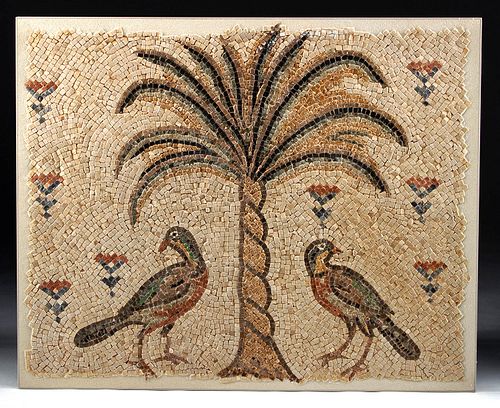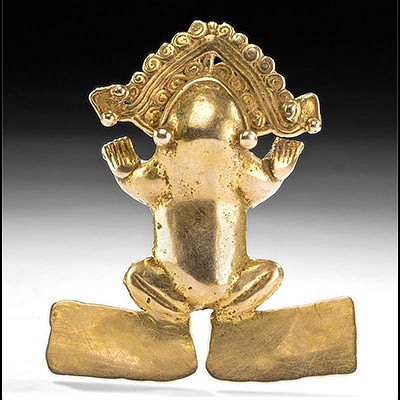Roman Mosaic with Birds and Palm Tree
Lot 39e
About Seller
Artemis Fine Arts
686 S Taylor Ave, Ste 106
Louisville, CO 80027
United States
Selling antiquities, ancient and ethnographic art online since 1993, Artemis Gallery specializes in Classical Antiquities (Egyptian, Greek, Roman, Near Eastern), Asian, Pre-Columbian, African / Tribal / Oceanographic art. Our extensive inventory includes pottery, stone, metal, wood, glass and textil...Read more
Categories
Estimate:
$10,000 - $15,000
Absentee vs Live bid
Two ways to bid:
- Leave a max absentee bid and the platform will bid on your behalf up to your maximum bid during the live auction.
- Bid live during the auction and your bids will be submitted real-time to the auctioneer.
Bid Increments
| Price | Bid Increment |
|---|---|
| $0 | $25 |
| $300 | $50 |
| $1,000 | $100 |
| $2,000 | $250 |
| $5,000 | $500 |
| $10,000 | $1,000 |
| $20,000 | $2,500 |
| $50,000 | $5,000 |
| $100,000 | $10,000 |
| $200,000 | $20,000 |
About Auction
By Artemis Fine Arts
Aug 13, 2020
Set Reminder
2020-08-13 10:00:00
2020-08-13 10:00:00
America/New_York
Bidsquare
Bidsquare : Fine Antiquities, Ethnographic & Fine Art
https://www.bidsquare.com/auctions/artemis-gallery/fine-antiquities-ethnographic-fine-art-5415
Features classical antiquities, ancient and ethnographic art from cultures encompassing the globe. Egyptian, Greek, Roman, Etruscan, Near Eastern, Asian, Pre-Columbian, Native American, African / Tribal, Oceanic, Spanish Colonial, Russian, Fine Art, so much more! Artemis Fine Arts info@artemisfinearts.com
Features classical antiquities, ancient and ethnographic art from cultures encompassing the globe. Egyptian, Greek, Roman, Etruscan, Near Eastern, Asian, Pre-Columbian, Native American, African / Tribal, Oceanic, Spanish Colonial, Russian, Fine Art, so much more! Artemis Fine Arts info@artemisfinearts.com
- Lot Description
Roman, the Levant, late Imperial Period, ca. 4th to 6th century CE. A well-executed mosaic that depicts two birds - perhaps ducks, doves, or quail - beneath a tall fruitful palm tree with flowers in the field. All is delineated with square/rectangular stone tesserae of caramel, cocoa, russt red, and various shades of green - seafoam, spring, and olive green - against a peachy cream ground. The birds are delineated in a naturalistic manner with great attention to detail, presenting our feathered friends' in composite profile with carefully delineated eyes, beaks, wings, plumage, and perched feet. In contrast, the palm tree above is rendered out of scale - only about twice as tall as each bird - in a somewhat irrational manner that one finds in Roman Fourth Style wall paintings. Size (mosaic): 35.75" W x 28.5" H (90.8 cm x 72.4 cm); (frame): 36.8" W x 29.8" H (93.5 cm x 75.7 cm)
The iconography of this mosaic would have conveyed great symbolism in ancient Rome. Palm trees were especially significant in the ancient world - symbolizing peace, victory, and immortality. In ancient Rome the palm frond as well as the tree itself personified Victory. This meaning may be traced to ancient Greece where a palm branch was presented to the victors of athletic events. Furthermore, given that victory implies the end of a competition, rivalry, or conflict, the palm came to be a symbol of peace. In addition, in Mesopotamia and ancient Egypt, the palm signified immortality, and in Judaism, closed date palm fronds became a critical component of the lulav cherished during Sukkot to commemorate the years the Jewish people spent in the desert prior to reaching the Promised Land.
Birds - and indeed, animals of all kinds - were incredibly popular artistic themes in the Roman Empire. Romans delighted in seeing animals, and a major industry during the imperial period was the capture and transport of birds, mammals, and lizards for display and sport in the Roman arena. Ancient Roman mosaic artwork reflects this interest. For example, at Pompeii, there are multiple mosaics depicting well-rendered, lifelike birds engaging in a variety of activities - sitting in trees, warily watching cats, and in the case of one partridge, plucking at a necklace as if to steal it. Based on the locations where mosaics depicting birds have been found, scholars believe that birds were regarded as tranquil, peaceful subjects for the interiors of homes (not so the case with many other types of animals).
Mosaics (opus tesellatum) are some of our enduring images from the Roman world, not only for their aesthetic beauty, but also because they reveal what Romans chose to depict and see every day decorating their private and public spaces. This piece at first glance seems quite simple - two birds below a palm tree. However, the symbolism of the iconography is layered and rich. Perhaps this piece is commemorating a victory that recently occurred in a Roman arena - perhaps it is a statement of peace - perhaps a plea for longevity or eternal life. While impossible to know for certain, one can muse on these possibilities and certainly appreciate the immense skill and technique it took to create.
Provenance: ex-Phoenicia Holyland Antiquities, New York, New York, USA; ex-Fortuna Fine Arts, LLC, New York, New York, USA, collected in the 1990s
All items legal to buy/sell under U.S. Statute covering cultural patrimony Code 2600, CHAPTER 14, and are guaranteed to be as described or your money back.
A Certificate of Authenticity will accompany all winning bids.
We ship worldwide and handle all shipping in-house for your convenience.
#157321Mounted on a concrete backing and framed. Small losses, chips, and a few stable fissures to some tesserae, with some stable hairline fissures to cement matrix, and light encrustations, otherwise in beautiful condition with great preservation of imagery.Condition
- Shipping Info
-
All shipping is handled in-house for your convenience. Your invoice from Artemis Gallery will include shipping calculation instructions. If in doubt, please inquire BEFORE bidding for estimated shipping costs for individual items.
-
- Buyer's Premium



 EUR
EUR CAD
CAD AUD
AUD GBP
GBP MXN
MXN HKD
HKD CNY
CNY MYR
MYR SEK
SEK SGD
SGD CHF
CHF THB
THB
















